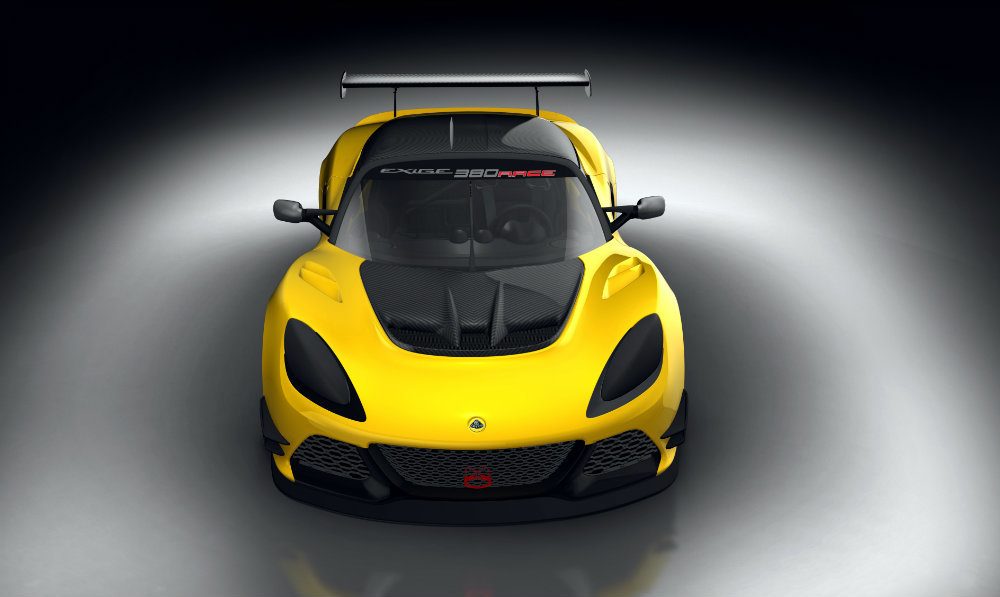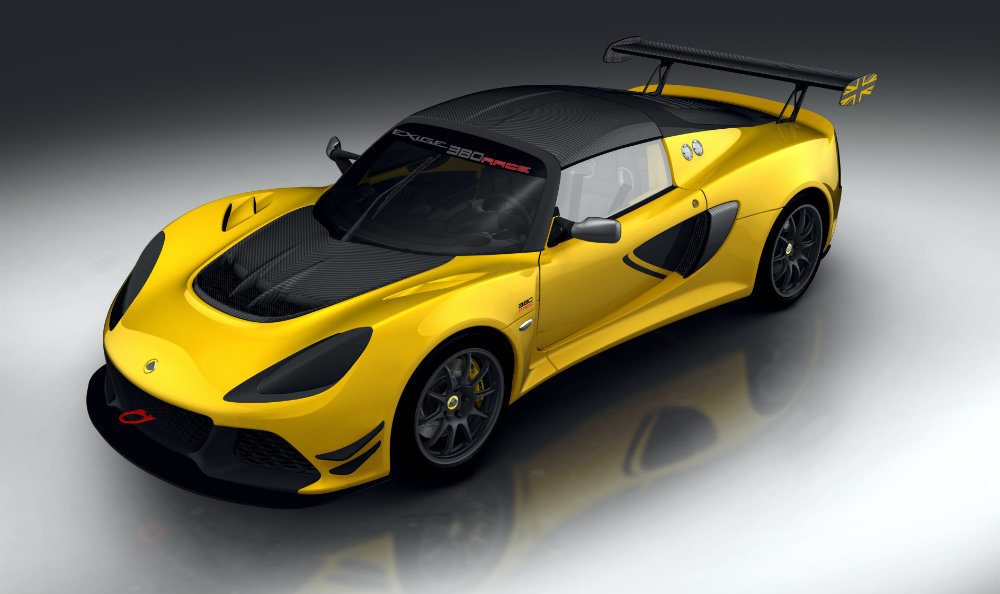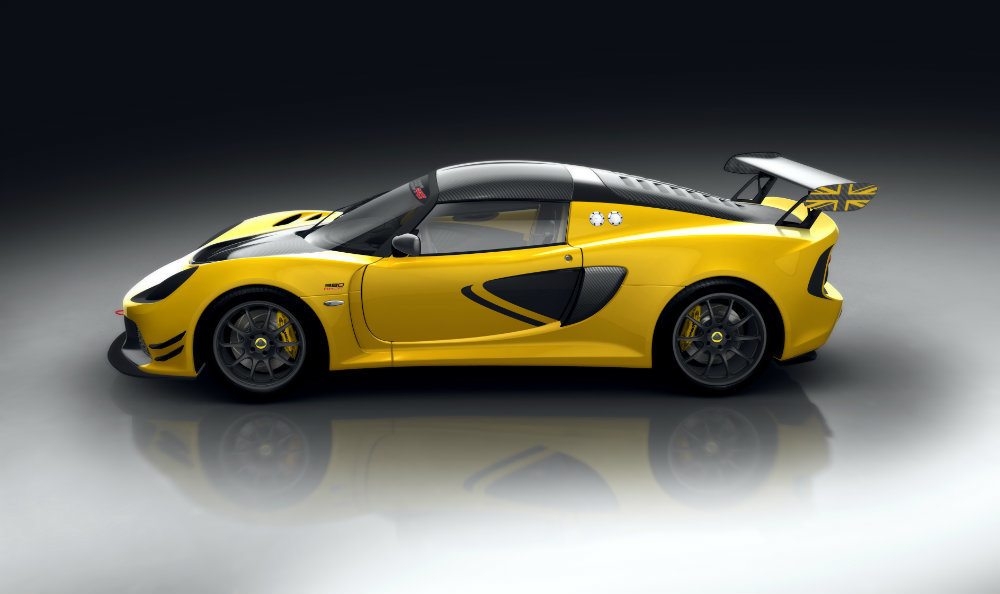Colin Chapman, founder of Lotus Cars, had a personal motto, a dictum, if you will: “To go fast, add lightness.” He was fanatical about the concept. And even though Colin shrugged off this mortal suspension coil back in 1982, his motto lives on, embodied in the 2017 Lotus Exige Race 380A.
If you’re a by the figures, aerospace engineer sort of person (like Colin was), you won’t have to know much beyond this: 2,200 lbs. dry weight, 375 horsepower, 302 lb-ft. of torque, 240 kg aerodynamic downforce, and 1.5 seconds quicker around the company’s Hethel test track.
Also, 0-60 mph in 3.2 seconds.
Let me put that into perspective for you: This thing weighs about the same as a first-gen Mazda Miata and puts out three-and-a-half times more power and torque. Three-and-a-half times!
This thing would be unbeatable on an Auto-X course, but why mess around with childish toys like cones. Take this thing to a track. A real track. Like, oh, the Nürburgring. What to stack this up against the new Vette? A Cayman GTS? Bring it. Yes, there are some long straight sections where power is king (although 375 horses is nothing to sneeze at), but everywhere else on that track?
Adios muchachos.
Lather And Nothing Else
Now that I’ve worked myself into a fine lather, it’s time to calm down, and deal with the harsh, perhaps harshest of realities about the 2017 Lotus Exige Race 380. It is a track only car, and cannot be licensed for road use. My dreams of blasting down the PCH (let’s say to Half Moon Bay for a late breakfast) with all due haste in this thing are now dashed. But so be it. I was prepared for that.
The Lotus Exige Race 380 is, as one would suspect, based on the Exige Sport 380, and comes with a slew of competition-focused components standard. Gearbox, suspension, aerodynamics, and the electrical systems are among the items that have all had a going over, so as to be up to the car’s new role but, curiously, the majority of the original car’s configuration is retained, thanks to the fact the Exige Sport 380 is very high up on the performance charts already.
It’s also worth noting that, from a sales perspective (something that Colin, frankly, sucked at paying attention to), the Lotus Exige Sport 380 has proved to be one of Lotus’ most successful new models in recent years. So, if you’re a track-tard with a penchant for Lotii, and enough cash, this will probably be the car for you.
Jean-Marc Gales, CEO of Group Lotus said the Exige Race 380 is “an unparalleled race car that follows the philosophy of Colin Chapman and we can’t wait for customers to experience its capabilities.” And yeah, he’s biased. And yeah, he’s kind of paid to say stuff like that, but the numbers back the guy up.
The Exige Race 380 can lap the company’s Hethel test track 1.5 seconds quicker (phenomenal) than the previous Exige Cup R. The Hethel track is kind of like the old Top Gear test track. It’s a converted air base and not very long around. So carving 1.5 seconds off a lap record on a track that short is a notable accomplishment.
Race Ready
The Lotus Exige Race 380 retains the race-proven 3.5-liter supercharged V6 mill from the street car, but it’s now cranking out 375 horsepower at 6,700 rpm and 302 lb-ft. of torque at 5,000 rpm. The car comes with an Xtrac 6-speed sequential transmission, oil cooler, and cassette-type plate limited slip differential. Said sequential transmission is managed by carbon paddles located behind the steering wheel.
If you go with the full titanium exhaust system, you shave another 10 kilos from beyond the rear axle, and besides, titanium is cool. All of this means the Exige Race 380 flashes from 0-60 in just 3.2 seconds.
Lotus got more performance out of the car’s aerodynamics as well. The Race 380 produces 240 kg of downforce at 170 mph. That’s like having a fat guy sitting on each bumper, minus the drag penalty. Further aero tricks include vents incorporated into the front bodywork and rear bumper to reduce pressure around the wheels and further increase downforce. There’s a new grille mounted at the rear that aids air circulation through the engine bay. Which is good, because the higher the performance, the closer to the thermal limit cars will run.
There is also a new front splitter to reduce pressure beneath the Exige, while the rear diffuser and larger, straight-cut motorsport rear wing, mounted to the bodywork, modify airflow at the rear of the car.
Essential Equipment
The Exige Sport 380 rides on Michelin Pilot Sport Cup 2 tires as standard; 215/45 ZR17 at the front; 265/35 ZR18 at the rear. These wrap around the car’s ultra-lightweight forged alloy wheels. Stopping comes courtesy of AP Racing forged, four-piston calipers, and grooved two-piece brake discs. Why four-piston calipers? Why not six, you zealously ask? Because this is a Lotus, and it is light, so it only needs brakes of a certain size.
To go with more, simply for the sake of going with more, serves no real performance purpose and will only add weight. Four will do.
The revised suspension configuration incorporates 2-way adjustable Öhlins dampers (nice) and adjustable front and rear anti-roll bars (also nice). Together with the Lotus Traction Control System, where wheel slip can be adjusted by the driver from the cockpit, owners can easily fine tune the vehicle’s handling characteristics.
There is a full, integrated roll cage, lightweight FIA Carbon driver’s seat (HANS compatible, natch), and a six-point harness. There are ultra-lightweight polycarbonate side windows, a competition specification fire extinguisher, battery isolator, and fore and aft motorsport towing eyes. Additional performance features include an ultra-lightweight carbon fiber, motorsport specific louvered tailgate panel (fitted over the engine), and carbon fiber air intake pods that sit either side of the car, just forward of the rear wheels.
There are no headlights, only matt black covers. Airbags are not included in the specification.
Special Treatments
Inside the cockpit, there is a color TFT instrument cluster that serves up numerous user friendly and programmable screen configurations. There is a track data logger and GPS unit (why?), and you can add professional data analysis software, if you’re really into that sort of thing. The front inspection cover, hard top, and diffuser surround are all hand-made carbon-fiber components and make for a nice finishing touch.
Speaking of finishing, the Exige Race 380 will also finish off a major portion of your checking account, ringing up at £99,500, around $125,000 USD.
So, yeah, not exactly cheap, but hey, speed comes at a price.
Tony Borroz has spent his entire life racing antique and sports cars. He means well, even if he has a bias towards lighter, agile cars rather than big engine muscle cars or family sedans.
Photos & Source: Group Lotus plc.
from Automoblog.net http://www.automoblog.net/2017/01/15/lotus-exige-race-380-a-dictum-in-physical-form/
via IFTTT
from Tumblr http://peternpalmer.tumblr.com/post/155925548746
via IFTTT



No comments:
Post a Comment